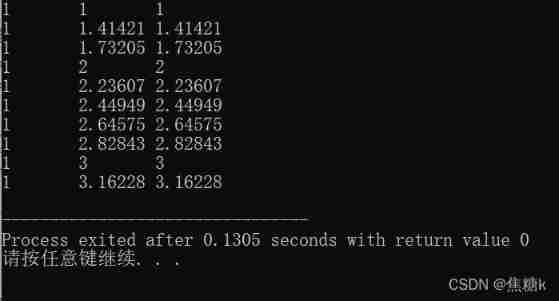当前位置:网站首页>Create a complete binary tree in array order
Create a complete binary tree in array order
2022-06-25 05:42:00 【Axyzstra】
Insert into the binary tree in array order
The correspondence between array and binary tree : The sequence number of a node in the array i, Then the left child node serial number is 2 * i, The serial number of the right child node is 2 * i + 1;
According to this relationship , We can build a binary tree in array order ;
Code instructions : By array arr Establish a binary tree in sequence ,i The position of the currently inserted element in the array ,n Is the number of array elements ,root Is the node address of this insertion ; This function is used to put arr[i] The element is inserted into the address root Location , So node root The inserted element of the left child node is arr[2 * i], The inserted element of the right child node is arr[2 * i + 1]; Create one node at a time , The created node is the left and right nodes corresponding to the previous node ;
node* insertLeverOrder(Type arr[], node* &root, int i, int n) {
if(i < n) {
node* temp = create(arr[i]); // Create a new node
root = temp;
root->lchild = insertLeverOrder(arr, root->lchild, 2 * i, n);
root->rchild = insertLeverOrder(arr, root->rchild, 2 * i + 1, n);
}
return root;
}
Now the insertion order is ‘A’, ‘B’, ‘C’, ‘D’, ‘E’, ‘F’, ‘G’ The inserted binary tree is as follows :

The complete code is as follows :
#include<iostream>
using namespace std;
typedef char Type;
struct node {
Type data;
node* lchild;
node* rchild;
};
node* create(Type x) {
// Create a node
node* n = new node;
n->data = x;
n->lchild = n->rchild = NULL;
return n;
}
// adopt arr[i] Element creation root node , Note that root Reference to address
node* insertLeverOrder(Type arr[], node* &root, int i, int n) {
if(i < n) {
node* temp = create(arr[i]);
root = temp;
root->lchild = insertLeverOrder(arr, root->lchild, 2 * i, n);
root->rchild = insertLeverOrder(arr, root->rchild, 2 * i + 1, n);
}
return root;
}
// In the sequence traversal
void inorder(node* root) {
if(root == NULL) {
return;
}
inorder(root->lchild);
printf("%c\n", root->data);
inorder(root->rchild);
}
int main() {
// Don't put the element in the first position , Because the index is zero 0 You cannot access its left child node (2 * i = 0)
Type data[8] = {
'0', 'A', 'B', 'C', 'D', 'E', 'F', 'G'};
node* root = insertLeverOrder(data, root, 1, 8);
inorder(root);
return 0;
}
Of course, using static storage is simpler , That is, use an array to store a binary tree , If the position of a node in the array is i, Its left child node and right child node are 2 * i and 2 * i + 1; You don't need to use a pointer ;
边栏推荐
- Use of pytorch tensorboard
- Flex flexible layout for mobile terminal page production
- Go Context - Cancelation and Propagation
- What happens when you use "-fno exceptions", "new T"- With “-fno-exceptions”, what happens with “new T”?
- Voxel based and second network learning
- ThreadLocal
- Personalized Federated Learning with Moreau Envelopes
- JS verification code input number auto skip
- ERDAS 9.2 installation tutorial
- Can bus extended frame
猜你喜欢

Create an environment for new projects
![The k-th node of the binary search tree [sword finger offer]](/img/9c/26b508100d8b49c114cf72346a8e7c.jpg)
The k-th node of the binary search tree [sword finger offer]

Volatile and JMM memory models

C language -- Sanzi chess

Semantic segmentation cvpr2020 unsupervised intra domain adaptation for semantic segmentation through self supervision

The article is on the list. Welcome to learn

Double recursion in deep analysis merge sort

2.20 learning content

Read the general components of antd source code

JSON Library Tutorial from scratch (II): parsing digital learning and sorting notes
随机推荐
DOM document object model (I)
BUUCTF(web:1-50)
Example of dynamic programming 3 leetcode 55
Solve some prompt codes that pychar cannot recognize selenium
UVA816 Abbott’s Revenge
H5 native player [learn video]
Transformations of pytorch torch torch vision
Use of MySQL variables
Create an environment for new projects
Bind simulation, key points of interpreting bind handwritten code [details]
Farewell to Lombok in 996
How to add an external header file in vs?
Depth of binary tree
Array: force deduction dichotomy
Instant messaging project (I)
JSON Library Tutorial from scratch (II): parsing digital learning and sorting notes
Stack and Queue
Code learning-cvpr2020 unsupervised domain adaptive semantic segmentation: intra advance
Professional things use professional people
Learn the interface test, see it is very good, and make a note